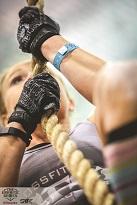

The intention of this event is to offer a world-class fitness competition experience to those who enjoy fitness, who want to challenge themselves, but who have 9-to-5 jobs and lives outside the gym. The Granite Games provides the chance to take fitness onto the arena floor and to move outside of the gym and comfort zone.
It’s probably fair to characterize our athletes as being driven by a goal of well-rounded fitness, and to be very good at many different types of movements, yet not specialists. They train in gymnastics, weightlifting and metabolic condition (such as running or rowing), with the goal of being the overall best. It’s not the athlete who can lift the heaviest weights or the one who can run the quickest 5K that will come out on top, but rather the one who is consistent in their fitness across the board. “Out-run a lifter, out-lift a runner” is a good way to sum up the mentality of what these athletes work toward every day with their fitness.
 History of the Sport
History of the Sport
The growth of fitness competition is evident across the nation, and in recent years, it has exploded in popularity. The history of the Granite Games’ growth is one illustration. The Granite began in 2011 when a fledgling gym called CrossFit Fast Factory decided to have an informal fitness competition. Known as the Cloudy Town Throw Down, the one-day competition hosted 40 athletes in three events. It’s important to note that the Granite Games, in its current and previous incarnations, is not to be confused with a “CrossFit competition.” We offer athletes a functional fitness event in which to test themselves.
In its second year, Cloudy Town more than doubled in size with 90 athletes. By its third year, the competition had undergone a metamorphosis into the Granite Games. The competition, now a three-day event, relocated to St. Cloud State University’s field house to accommodate the growing crowd of not just athletes, but also spectators. There were more events and more divisions, with athletes competing as Scaled, Masters, AsRx, Team and Elite.
Clearly, the word is spreading about functional fitness and the Granite Games’ popularity reflects that. This year, in addition to the field house, we expanded into the university’s hockey facility to accommodate a need for even more competition space. Our title also grew, as we acquired a lead sponsor, making us the Granite Games Powered by Progenex.
Functional fitness has come into its own as an industry. There are dedicated gyms, coaches, websites with information and suggested workouts, and of course, plenty of products for people who want them. The Granite Games now offers a Vendor Expo, with home gym equipment and rigs, supplements and so forth.
 The Fitness Community
The Fitness Community
In large part, the Granite Games flourishes because of the strong community behind this type of fitness. Athletes who pursue functional fitness in their daily lives are incredibly supportive of each other. Fans at competitions are intimately acquainted with the physical demands and even pain that these competitors are going through on the arena floor. These fans have experienced firsthand the movements and the “suck,” as it is fondly known.
Of course, not all functional fitness athletes are interested in competing at the Granite Games (or anywhere else). Many simply want to improve their fitness level, stay healthy and increase their longevity. And that’s okay, because the community welcomes athletes of all levels and interests.
The Facilities
Our competition evolved from taking place within a garage gym to occupying two huge buildings on the campus of a state university. The field house has an acrylic sports floor, while the National Hockey Center is literally a hockey arena. The ice is removed and the concrete covered with rubber matting for the events. The cubic footage is massive, but we use all of it. In addition to competition space fully stocked with weights, barbells and rigging, we set up an athletes-only area to provide a place for competitors to relax and recuperate between events, as well as a warm-up area to prep for go-time.
 In considering venues in which to host a competition, you’re looking for a few key things. It is crucial to have a basis of support in the community, since people who are already active in local gyms and programs will be interested in participating, watching and volunteering. It’s also important to consider the proximity to hotels, restaurants and other amenities, as well as convenience and accessibility of the location.
In considering venues in which to host a competition, you’re looking for a few key things. It is crucial to have a basis of support in the community, since people who are already active in local gyms and programs will be interested in participating, watching and volunteering. It’s also important to consider the proximity to hotels, restaurants and other amenities, as well as convenience and accessibility of the location.
In our first year, spectators packed a gym to watch their friends and family compete. Now, we have around 2,500 people making up our audience, making it necessary to rent bleachers. In addition to having more athletes competing, the influx is also owed to the addition of our Elite division. Elite athletes are by invitation-only and are well-known within the fitness community. Many of them have sponsorships and compete throughout the year.
In order to have a successful event, you need a clear vision of what you want and a well-thought out plan for making that happen. A big part of your event’s success will lie in finding the right place. You can’t just choose any old place and try to make it work. Envision it from everyone’s perspective—from athlete to spectator—and determine what everyone needs.
 The Support
The Support
We plan for every contingency. There are paramedics and support personnel, as well as police and campus security. Our own volunteers are partitioned into medical, athlete control, athlete support, registration, set-up, tear down… the list goes on. If you’re planning an event, prepare for all possible situations and scenarios and plan accordingly.
The Athletes
Athletes at the Granite Games are health-conscious, and many are very specific about their dietary needs. Some are strict paleo eaters, many have specific supplementation and recovery requirements, and most have routines for implementing pre- and post-workout nutrition. We try to accommodate these needs with ample recovery time between workouts and a secure area where they can relax.
With the exception of the Elite (and many of them are juggling multiple priorities in their daily lives), most Granite Games athletes fall into the category of weekend warriors. They’re very fit and they’re enjoying the competition, but they have jobs and families and other obligations. Some want to add an edge to their training, others want their first taste of competition and some strive for the podium. It takes all kinds, and the event accommodates them all.
 Planning and Promoting a Fitness Competition
Planning and Promoting a Fitness Competition
We can’t speak for everyone, but for our staff, planning is a year-round project. We have a dedicated staff with specialization in social media, graphic design, content writing and more, with the goal of promoting the event throughout the year in e-mail blasts, on our website and via social media. And of course, we want to get in touch with gyms in the fitness community, to allow them to get their members aware, involved and excited for the event throughout the year. These communities have an opportunity to benefit themselves and their members by participating in our revenue sharing program, allowing them to invest back into their facilities, equipment and programs.
Our social media presence is extensive, with Twitter, Instagram and Facebook accounts —our Facebook page currently has over 17,000 followers. The strong following that the Granite Games has online has permitted us to keep in constant contact with participating communities, as well as the athletes who are already planning for next year’s event. It’s not uncommon for us to be fielding messages like, ‘What are the dates for the Games for 2015? I want to plan my wedding around it.’ Yes, people send us those kinds of messages. Really.

